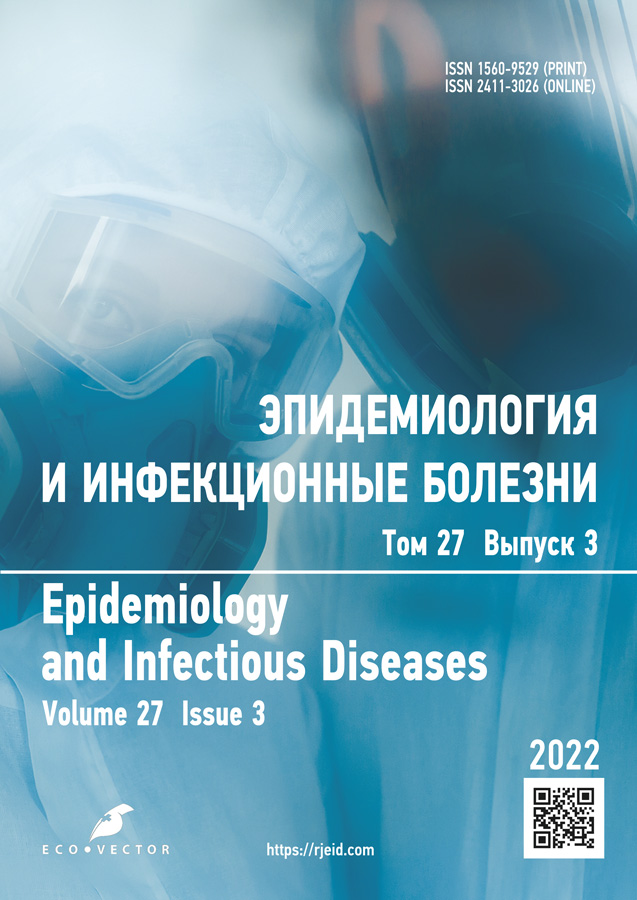Анализ микробиома кишечника ВИЧ-инфицированных пациентов с использованием 16S рРНК секвенирования
- Авторы: Попова Д.М.1,2, Вознесенский С.Л.1, Петрова Е.В.2, Климкова П.В.2
-
Учреждения:
- Российский университет дружбы народов
- Инфекционная клиническая больница № 2, Москва
- Выпуск: Том 27, № 3 (2022)
- Страницы: 164-174
- Раздел: Оригинальные исследования
- Статья получена: 09.08.2022
- Статья одобрена: 17.10.2022
- Статья опубликована: 13.12.2022
- URL: https://rjeid.com/1560-9529/article/view/109701
- DOI: https://doi.org/10.17816/EID109701
- ID: 109701
Цитировать
Полный текст
Аннотация
Обоснование. Микробиота желудочно-кишечного тракта является одним из важных факторов, обеспечивающих нормальную жизнедеятельность человеческого организма. Пациенты с ВИЧ-инфекцией наиболее подвержены кишечным инфекциям и изменениям в составе микробиоты как вследствие воздействия самого вируса, так и в результате снижения иммунитета. В данной статье описываются изменения в составе кишечной микрофлоры пациентов с ВИЧ-инфекцией на стадии вторичных заболеваний, получающих и не получающих антиретровирусную терапию.
Цель исследования — определить состав микробиома кишечника у пациентов с ВИЧ-инфекцией на антиретровирусной терапии и вне её с помощью секвенирования ДНК гипервариабельных регионов гена 16S рРНК.
Материалы и методы. Объектом исследования была группа пациентов в количестве 10 человек с документально подтверждённым диагнозом ВИЧ-инфекции и диарейным синдромом. С целью уточнения возможного этиологического фактора и определения особенностей микробиоценоза желудочно-кишечного тракта был проведён анализ кала методом 16S рРНК секвенирования.
Результаты. В ходе исследования выявлены значительные изменения в составе микробиома: обеднение типа Bacteroidetes, повышенное число типа Proteobacteria. Установлена статистически значимая разница в составе типов микробиоты здоровых людей и c ВИЧ-инфекцией (p <0,05). Нормофлора была представлена всего лишь двумя микроорганизмами — Bifidobacterium breve и Lactobacillus rhamnosus. Были выявлены условно-патогенные виды микроорганизмов: Enterococcus faecium, E. faecalis, Escherichia coli, Klebsiella pneumoniae, Citrobacter freundii, E. durans, Klebsiella sp., Pantoea agglomerans, K. variicola, E. hirae, E. coli TOP550-1, Clostridioides difficile, Staphylococcus aureus. Данные бактерии могут быть причиной диарейного синдрома у пациентов с ВИЧ-инфекцией.
Заключение. У пациентов с ВИЧ-инфекцией снижено бактериальное разнообразие, обеднена нормофлора, формируется специфический микробный профиль. Ряд условно-патогенных микроорганизмов могут быть причиной диареи у пациентов с ВИЧ-инфекцией. Анализ 16S рРНК секвенирования может использоваться как неинвазивный метод диагностики изменения состава кишечной микрофлоры и с целью уточнения этиологического фактора диарейного синдрома.
Ключевые слова
Полный текст
Об авторах
Дарья Михайловна Попова
Российский университет дружбы народов; Инфекционная клиническая больница № 2, Москва
Email: popova-d@rudn.ru
ORCID iD: 0000-0002-4056-9192
Россия, Москва; Москва
Сергей Леонидович Вознесенский
Российский университет дружбы народов
Автор, ответственный за переписку.
Email: voznesenskiy-sl@rudn.ru
ORCID iD: 0000-0001-5669-1910
SPIN-код: 4487-6744
к.м.н., доцент
Россия, МоскваЕлена Викторовна Петрова
Инфекционная клиническая больница № 2, Москва
Email: evi1963@yandex.ru
ORCID iD: 0000-0002-6896-6851
Россия, Москва
Полина Викторовна Климкова
Инфекционная клиническая больница № 2, Москва
Email: pvk20@mail.ru
ORCID iD: 0000-0001-6046-7815
Россия, Москва
Список литературы
- Стома И.О. Микробиом в медицине: руководство для врачей. Москва: ГЭОТАР-Медиа, 2020. 320 с. doi: 10.33029/9704-5844-0-MIM-2020-1-320
- Qin J., Li R., Raes J., et al.; MetaHIT Consortium. A human gut microbial gene catalogue established by metagenomic sequencing // Nature. 2010. Vol. 464, N 7285. P. 59–65. doi: 10.1038/nature08821
- Massanella M., Fromentin R., Chomont N. Residual inflammation and viral reservoirs: alliance against an HIV cure // Curr Opin HIV AIDS. 2016. Vol. 11, N 2. P. 234–241. doi: 10.1097/COH.0000000000000230
- Chun T.W., Nickle D.C., Justement J.S., et al. Persistence of HIV in gut-associated lymphoid tissue despite long-term antiretroviral therapy // J Infect Dis. 2008. Vol. 197, N 5. P. 714–720. doi: 10.1086/527324
- Buckheit R.W. 3rd, Salgado M., Martins K.O., Blankson J.N. The implications of viral reservoirs on the elite control of HIV-1 infection // Cell Mol Life Sci. 2013. Vol. 70, N 6. P. 1009–1019. doi: 10.1007/s00018-012-1101-7
- Vesterbacka J., Rivera J., Noyan K., et al. Richer gut microbiota with distinct metabolic profile in HIV infected Elite Controllers // Sci Rep. 2017. Vol. 7, N 1. P. 6269. doi: 10.1038/s41598-017-06675-1
- Patel J.B. 16S rRNA gene sequencing for bacterial pathogen identification in the clinical laboratory // Mol Diagn. 2001. Vol. 6, N 4. P. 313–321. doi: 10.1054/modi.2001.29158
- Drancourt M., Bollet C., Carlioz A., et al. 16S ribosomal DNA sequence analysis of a large collection of environmental and clinical unidentifiable bacterial isolates // J Clin Microbiol. 2000. Vol. 38, N 10. P. 3623–3630. doi: 10.1128/JCM.38.10.3623-3630.2000
- Mignard S., Flandrois J.P. 16S rRNA sequencing in routine bacterial identification: a 30-month experiment // J Microbiol Methods. 2006. Vol. 67, N 3. P. 574–581. doi: 10.1016/j.mimet.2006.05.009
- Кожевников А.А., Раскина К.В., Мартынова Е.Ю., и др. Кишечная микробиота: современные представления о видовом составе, функциях и методах исследования // РМЖ. 2017. № 17. С. 1244–1247.
- Хлюстова Я. Бактерии Akkermansia: что это и как повысить их содержание в кишечнике // Атлас Блог. Режим доступа: https://atlas.ru/blog/baktierii-akkermansia-chto-eto-i-kak-povysit-ikh-sodierzhaniie-v-kishiechnikie/. Дата обращения: 10.11.2022.
- Prevotella (превотелла, род бактерий) // Исток-Система Гастроскан. Режим доступа: https://www.gastroscan.ru/handbook/118/7105. Дата обращения: 10.11.2022.
- Roseburia (розебурия, род бактерий) // Исток-Система Гастроскан. Режим доступа: https://www.gastroscan.ru/handbook/118/7643. Дата обращения: 10.11.2022.
- Qiao Y., Zhang Z., Zhai Y., et al. Apigenin Alleviates Obesity-Associated Metabolic Syndrome by Regulating the Composition of the Gut Microbiome // Front Microbiol. 2022. Vol. 12. P. 805827. doi: 10.3389/fmicb.2021.805827
- Eubacterium hallii // Исток-Система Гастроскан. Режим доступа: https://www.gastroscan.ru/handbook/118/8843. Дата обращения: 10.11.2022.
- Методы и объекты метагеномных исследований. Метагеномное секвенирование кишечной микробиоты. Режим доступа: http://propionix.ru/metagenomika-i-mikrobiom. Дата обращения: 10.11.2022.
- Crakes K.R., Jiang G. Gut Microbiome Alterations During HIV/SIV Infection: Implications for HIV Cure // Front Microbiol. 2019. Vol. 10. P. 1104. doi: 10.3389/fmicb.2019.01104
- Dillon S.M., Lee E.J., Kotter C.V., et al. An altered intestinal mucosal microbiome in HIV-1 infection is associated with mucosal and systemic immune activation and endotoxemia // Mucosal Immunol. 2014. Vol. 7, N 4. P. 983–994. doi: 10.1038/mi.2013.116
- Imahashi M., Ode H., Kobayashi A., et al. Impact of long-term antiretroviral therapy on gut and oral microbiotas in HIV-1-infected patients // Sci Rep. 2021. Vol. 11, N 1. P. 960. doi: 10.1038/s41598-020-80247-8
Дополнительные файлы








